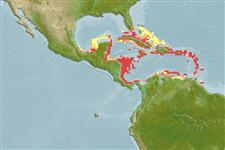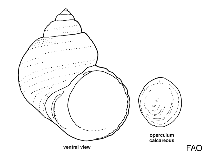Eulithidium adamsi (Philippi, 1853)
| Native range | All suitable habitat | Point map | Year 2050 |

|
| This map was computer-generated and has not yet been reviewed. |
| Eulithidium adamsi AquaMaps Data sources: GBIF OBIS |
Adicionar o seu Fotografias
Imagem do Google | No image available for this species;
drawing shows typical species in Turbinidae.
Imagem do Google | No image available for this species;
drawing shows typical species in Turbinidae.
Classification / Names Common names | Synonyms | CoL | ITIS | WoRMS
| Trochida | Turbinidae
Environment: milieu / climate zone / depth range / distribution range Ecologia
Associadas(os) a recifes; intervalo de profundidade 0 - 30 m (Ref. 109264). Tropical; 26°N - 9°N, 91°E - 60°E (Ref. 83435)
Distribuição Países | Áreas FAO | Ecossistemas | Ocorrências | Introduções
Western Central Atlantic.
Length at first maturity / Tamanho / Peso / Idade
Maturity: Lm ? range ? - ? cm Max length : 0.4 cm DL macho/indeterminado; (Ref. 83435)
This species is found in intertidal coral reefs, mangroves and cienaga facies, particularly on coral, mud, rocky and sandy habitats (Ref. 83934). Also on seagrass (Ref. 109264).
Life cycle and mating behavior Maturidade | Reprodução | Desova | Ovos | Fecundidade | Larvas
Members of the order Patellogastropoda are mostly gonochoric and broadcast spawners. Life cycle: Embryos develop into planktonic trocophore larvae and later into juvenile veligers before becoming fully grown adults.
Referência principal
Referências | Coordenador | Colaboradores
Miloslavich, P., J.M. Díaz, E. Klein, J.J. Alvarado, C. Díaz, J. Gobin, E. Escobar-Briones, Motta, J.J. Cruz, E. Weil, J. Cortés, A.C. Bastidas, R. Roberston, F. Zapata, A. Martín, J. Castillo, A. Kazandjian and M. Ortiz. 2010. (Ref. 86671)
Categoria na Lista Vermelha da IUCN (Ref. 130435)
Categoria CITES (Ref. 108899)
Not Evaluated
CMS (Ref. 116361)
Not Evaluated
Ameaça para o homem
Harmless
Utilização humana
| FishSource |
Ferramentas
Mais informação
Idade/Tamanho
Crescimento
Comprimento-peso
Comprimento-comprimento
Morfologia
Larvas
Abundância
Crescimento
Comprimento-peso
Comprimento-comprimento
Morfologia
Larvas
Abundância
Fontes da internet
BHL | BOLD Systems | CISTI | DiscoverLife | FAO(Publication : search) | Fishipedia | GenBank (genoma, nucleotídeo) | GloBI | Gomexsi | Google Books | Google Scholar | Google | PubMed | Árvore da vida | Wikipedia (ir para, procurar) | Registo zoológico
Estimates based on models
Preferred temperature
(Ref. 115969): 26.7 - 28.3, mean 27.6 (based on 401 cells).



